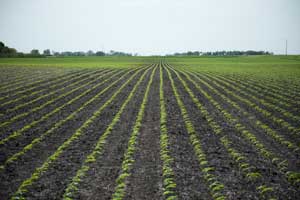Empty Grain Bins but Not Empty Pockets
If you are like me, you probably experience a degree of natural fear when exposed to heights, especially if there is little or no protection. After more than 30 years on the farm, I look no farther than the grain bin for this glaring example. In the fall, as harvest preparation is occurring, the one job that I hate doing is opening up the lids on the grain bins in preparation of filling them. Grain bins on our family farm have always been used to gauge how successful the crop year was. The hope was always to have more grain than storage because that would be a sign that the year was a success.
Over the last 2 years, we have begun to look at the grain bins in a different manner. With the challenges that have been faced in many regions, sub-par crops have led to empty grain bins. While the Corn Belt has produced 3 sub-par crops relative to the trend, on-farm incomes have continued to increase; even in the face of having grain bins that were short from being full. The one key component in this has been risk
management strategies that growers have utilized to protect revenue on their farms.
There are many ways that your crop insurance policies can work for you. The key in getting policies to work for you and your farm starts with how you look at using them. Most think about crop insurance only as a tool to protect income if the crop is damaged. We saw a significant need for crop insurance to serve in that role this past season. Some also rely on crop insurance as a way to protect from fluctuating market prices. How do you work marketing into this? Crop insurance allows you to market your crop to your level of coverage and take advantage of pricing opportunities that come before the bins are filled. The key component in doing this is to know your long term break evens. This number includes not only production costs, but short and long term debt, family living expenses, and profit. When you know your break even with profit built in at the levels you have insured your crop, it’s easy to be proactive with your marketing plan and take the emotion out of pricing your bushels.
In 2013, the greatest return on investment could very well be your election of policies for your farm. The decisions are not easy and must be tailored to your operation as they can equate to hundreds of thousands of dollars, both gained and lost. Do you have a risk management strategy for this growing season and are you going to use the tools before you fill your grain bins for 2013 prior to planting the crop? With the proper use of MPCI (Multi-Peril Crop Insurance) and additional specialty products, this year will be a great year for your operation. As MPCI is about to set its base revenue for the season, we will most likely have the opportunity to guarantee a break-even, or possibly a
marginal profit for your operation. In our diagram we picture a grain bin. If estimating break-even to be around $850/ac, with an average APH yield of 180bu/ac, the marketing break-even would be $4.72/bu. Dec. 2013 corn is trading around $5.75/bu., over a dollar per bushel profitability. What level of insurance are you thinking of taking to guarantee yourself a profitable year?
Historically, we purchase MPCI in March and do not think about it until after harvest and say to ourselves, “I’m sure glad we didn’t need that product again.” When I look at the last 20 years, the all-time high spring price was $6.01 in 2011, followed by $5.68 in 2012. Assuming our markets hold in the $5.75 range, we are able to assure a profit for your farm. In these same 20 years, 70% of the time the market price is lower by fall. With the revenue protection product, we are guaranteed a set revenue price so our down side risk is minimized.
The crop insurance deadline is fast approaching, with only a little over a month before the March 15th deadline. Farmers across the Corn Belt are still dealing with the emotions from last year’s harvest and growing season. We know that 2012 was a tough year, one that we can hopefully reminisce about in the future and not see repeated. At Corn Capital Innovations, our main concern for farmers is this: get your crop insurance set up so that you know what your bottom line protection is. Also, make sure you know what your protected bushels per acre are, and then you will know what your guarantees are. This will all result in the fact that if or when there is a market rally, you can act on it and not have to worry about overselling your guaranteed bushels versus your yield expectations.
Here at CCI, we take a look at the revenue products that are available and slot them into a policy selection matrix to make sure that we’re making the best recommendation for your operation. The policy section matrix is a tool developed by Water Street Solutions to provide the best risk management plan for your operation. We do realize that each operation is different in terms of complexity. That is why we are excited to sit down with each operation and determine an individualized risk management plan that will access what unit structure to take, what coverage levels to take, and what other products are available and should be considered for your overall risk.




 Every year around this time we review and plan our
Every year around this time we review and plan our  Corn Capital Innovations offers a full service of
Corn Capital Innovations offers a full service of 

